Last updated January 15, 2024
Read our article to discover how often people upgrade their phone, what the standard time period is for owning a handset, and which smartphones people hold on to the longest.
This article will offer statistics about the frequency with which smartphone owners upgrade their device.
It will show you which countries hold on to their existing smartphone the longest prior to upgrading.
The article will also look at the reasons why people upgrade their smartphones.
In this article, you will discover exactly how often people upgrade their phone. Until recently, it has been the case that people’s upgrade habits aligned with the cessation of the contract with their carrier. This, in most cases, would have been two years, but that timeframe seems to have given way to a longer period. Let’s look at how long people keep hold of their phone before they decide on an upgrade…
SellCell Key Findings:
- As of 2023, the global average replacement cycle length for a smartphone is 3.6 years.
- 40.4% of people upgrade their smartphone every two to three years.
- The majority of people (75.0%) upgrade their handset due to issues with their battery life shortening over time.
What Is a Phone Upgrade?
A phone upgrade refers to the process of replacing your current mobile device with a newer model, typically offering improved features, performance, and technology. This could involve getting the latest version of your existing phone model or switching to an entirely different device from the same or a different manufacturer. Phone upgrades are often driven by advancements in hardware, such as better cameras, faster processors, enhanced battery life, and updated software capabilities.
Phone owners can also decide to upgrade based on a desire to access new functionalities, stay current with technology trends, or address the evolving needs of the user. Carriers and manufacturers often provide options for customers to upgrade their phones through trade-in programs or installment plans, making the process accessible and convenient for users looking to stay on the cutting edge of mobile technology.
How Often Do People Upgrade Their Phone?
Many people upgrade their phone, and at different times within their respective phone’s lifecycle. Here, we will look at the global statistics for upgrade cycles, as well as by territory.
What Is the Replacement Cycle Length of Smartphones Globally?
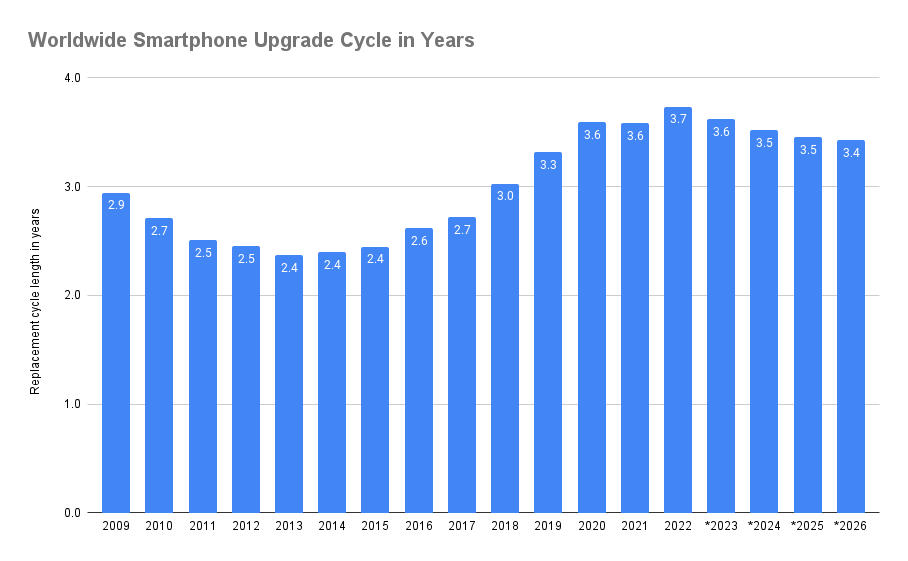
| Worldwide Smartphone Upgrade Cycle in Years | |
|---|---|
| Replacement cycle length in years | |
| 2009 | 2.9 |
| 2010 | 2.7 |
| 2011 | 2.5 |
| 2012 | 2.5 |
| 2013 | 2.4 |
| 2014 | 2.4 |
| 2015 | 2.4 |
| 2016 | 2.6 |
| 2017 | 2.7 |
| 2018 | 3.0 |
| 2019 | 3.3 |
| 2020 | 3.6 |
| 2021 | 3.6 |
| 2022 | 3.7 |
| *2023 | 3.6 |
| *2024 | 3.5 |
| *2025 | 3.5 |
| *2026 | 3.4 |
- On a global level, in 2013, consumer smartphones had an average replacement cycle length of 2.4 years. This was the lowest figure for smartphone retention that we see from the above data.
- The data also shows that, by 2022, the global figure for smartphone upgrades had reached its highest since 2013. The upgrade cycle reached 3.7 years.
- The average lifecycle of a smartphone in 2023 is 3.6 years, with only a month of 2023 remaining.
- Experts predict this figure will decrease as we move through 2023 and look forward to 2026.
What Is the Replacement Cycle Length of Smartphones in the USA?
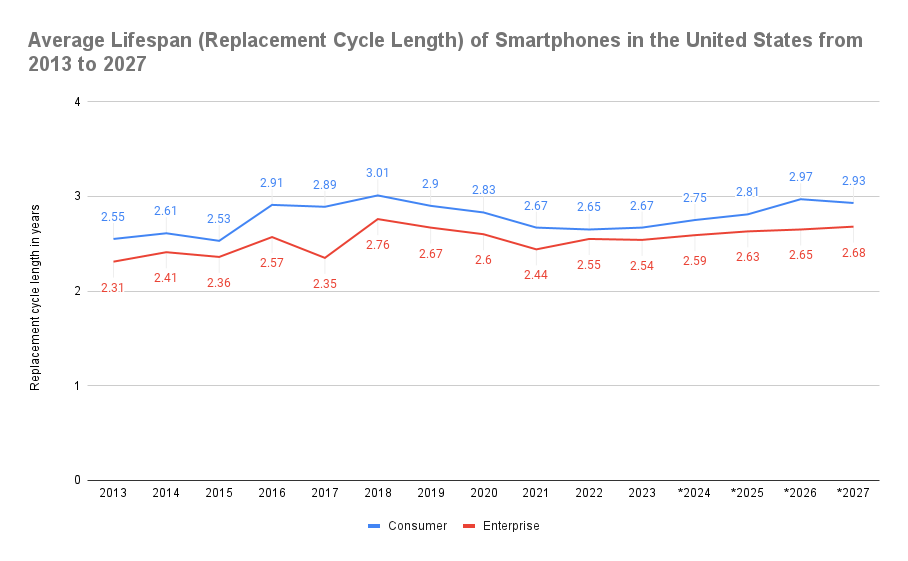
| Average lifespan (replacement cycle length) of smartphones in the United States from 2013 to 2027 | ||
|---|---|---|
| Consumer | Enterprise | |
| 2013 | 2.55 | 2.31 |
| 2014 | 2.61 | 2.41 |
| 2015 | 2.53 | 2.36 |
| 2016 | 2.91 | 2.57 |
| 2017 | 2.89 | 2.35 |
| 2018 | 3.01 | 2.76 |
| 2019 | 2.9 | 2.67 |
| 2020 | 2.83 | 2.6 |
| 2021 | 2.67 | 2.44 |
| 2022 | 2.65 | 2.55 |
| 2023 | 2.67 | 2.54 |
| *2024 | 2.75 | 2.59 |
| *2025 | 2.81 | 2.63 |
| *2026 | 2.97 | 2.65 |
| *2027 | 2.93 | 2.68 |
- For US consumers, the data graph above shows a replacement cycle length of 2.55 years in 2013. This is just over two years and six months.
- In 2018, the average lifespan of their existing smartphone reached an all-time high of 3.01 years. Consumers decided to upgrade three days into the third year of ownership.
- By 2023, this figure had dropped to 2.67 years, which is the equivalent of 2 years and eight months. Experts predict that this will continue to rise back to 2018 levels by 2026.
- For US enterprise phone users (business phones), the results aren’t drastically different. Upgrade cycles are shorter for enterprise phones. This is likely because businesses upgrade their smartphones as soon as possible, for a number of reasons. These could include:
- Up-to-date OS.
- Up-to-date security patches.
- It has fulfilled contractual obligations with the carrier service.
- The business requires a workforce with smartphones in peak condition.
- In 2013, US enterprises updated their phones every 2.31 years. As with consumer phones, this figure reached its all-time highest figure in 2018; 2.76 years. In 2023, replacement cycle length is 2.54 years, expected to rise to 2.68 years by 2027.
What Is the Replacement Cycle Length of Smartphones in Western Europe?
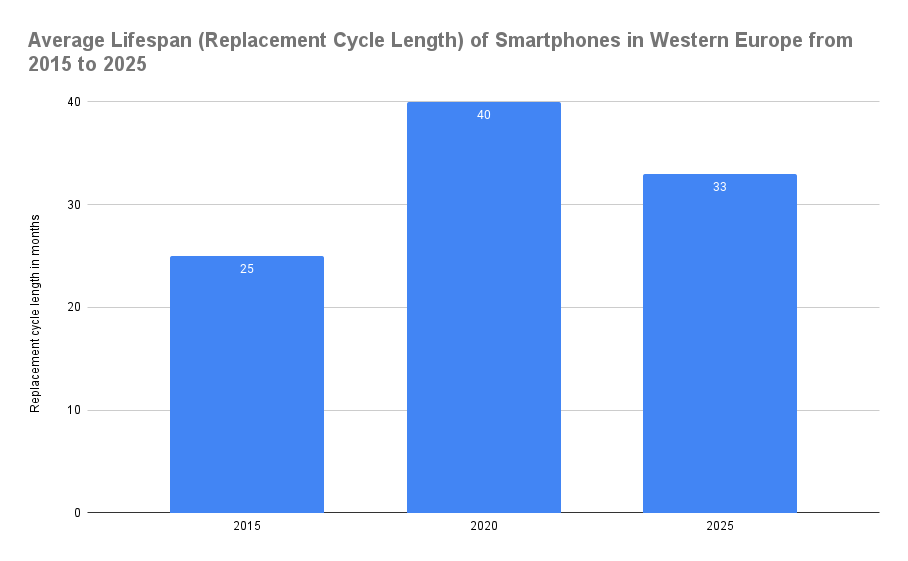
| Average Lifespan (Replacement Cycle Length) of Smartphones in Western Europe from 2015 to 2025 | |
|---|---|
| Replacement cycle length in months | |
| 2015 | 25 |
| 2020 | 40 |
| 2025 | 33 |
- In 2015, the average lifespan of a Western European smartphone was 25.0 months, before replacement. This is the equivalent of two years and one month.
- In 2020, this figure had risen to its highest peak, with smartphone replacement cycle length reaching 40 months, or three years and four months.
- According to the graph above, experts predict that replacement cycle length will drop back down to 33 months in 2025. This is equal to two years and nine months.
- Max Taylor, Vodafone CCO, states that, in the UK, a significant number of its customers keep their handset for up to four years 4.
What Is the Replacement Cycle Length of Smartphones in India?
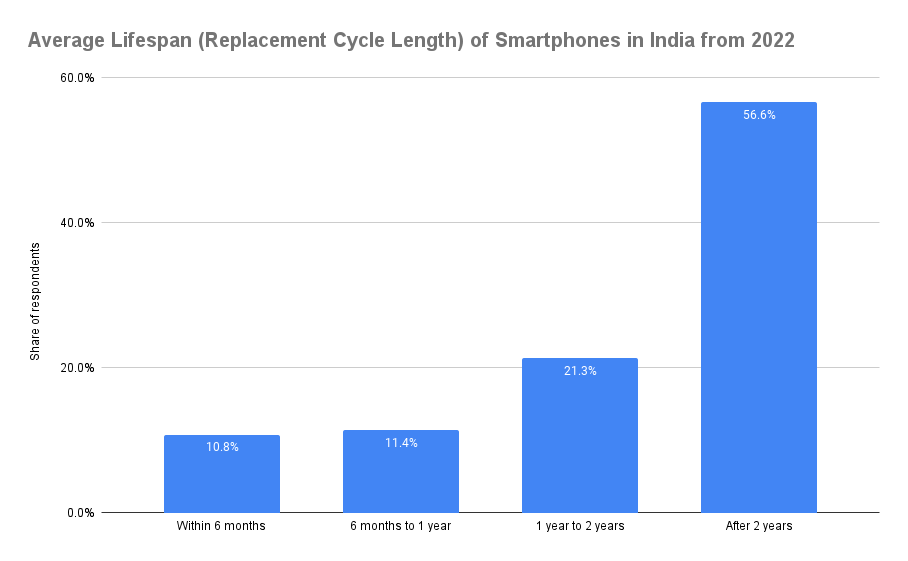
| Average Lifespan (Replacement Cycle Length) of Smartphones in India from 2022 | |
|---|---|
| Share of respondents | |
| Within 6 months | 10.8% |
| 6 months to 1 year | 11.4% |
| 1 year to 2 years | 21.3% |
| After 2 years | 56.6% |
- From 2022 onwards, most (56.6%) Indian smartphone owners upgrade their phone after two years of ownership.
- A surprising 10.8% of Indian people upgrade their smartphone after just six months. 11.4% of Indian smartphone owners make it to a year.
- 21.3% of Indian smartphones have a replacement cycle length between one and two years.
What Is the Replacement Cycle Length of Smartphones in China?
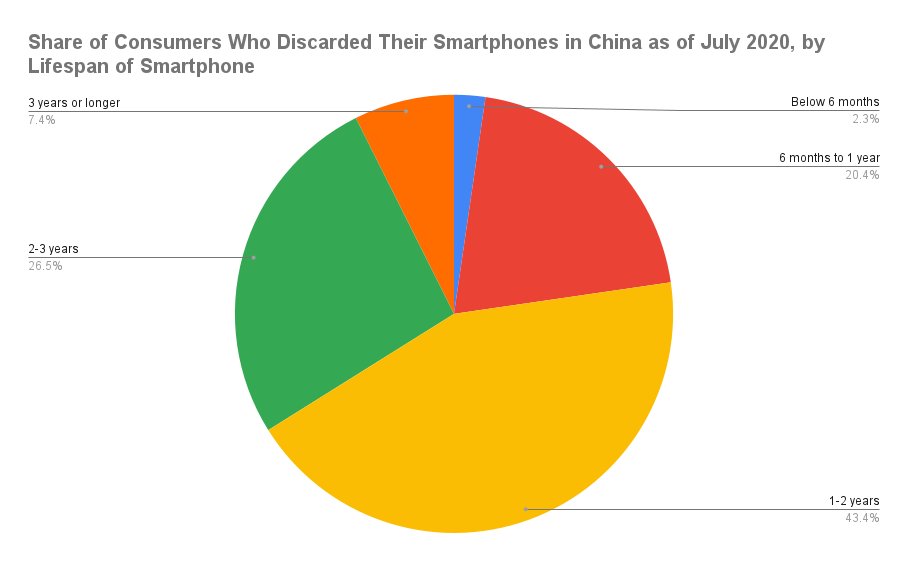
| Share of Consumers Who Discarded Their Smartphones in China as of July 2020, by Lifespan of Smartphone | |
|---|---|
| Share of respondents | |
| Below 6 months | 2.30% |
| 6 months to 1 year | 20.40% |
| 1-2 years | 43.40% |
| 2-3 years | 26.50% |
| 3 years or longer | 7.40% |
- The vast majority of Chinese smartphone owners (43.4%) keep their smartphone for between one and two years.
- Between two and three years is the second most popular lifespan for a Chinese smartphone. 26.5% of Chinese smartphone owners keep their phone this long.
- 20.4% of Chinese smartphones last between six months and a year before an upgrade. 2.3% make it less than six months.
- Only 7.4% of Chinese people upgrade their smartphone after three years.
What Is the Replacement Cycle Length of Smartphones in Other Parts of the World?
- According to research, 33% of Mexicans upgrade their phone every 18 months 7.
- In Japan, people hold on to their smartphone for a total of 26 months before they decide to upgrade 7.
Survey Data: How Often Do People Upgrade Their Smartphone?
SellCell collated data from four separate surveys to ascertain how long respondents, on average, keep their smartphone.
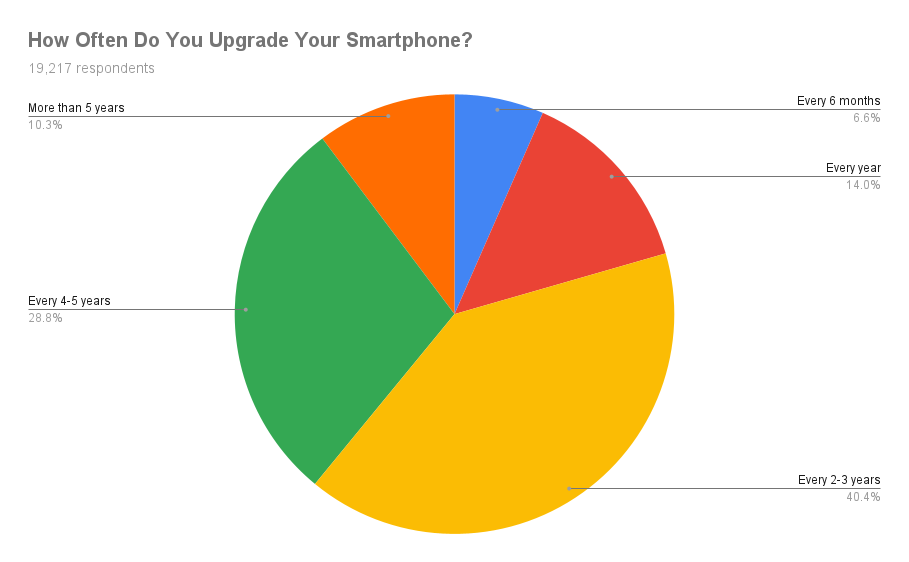
| How Often Do You Upgrade Your Smartphone? | |
|---|---|
| Share of respondents | |
| Every 6 months | 6.6% |
| Every year | 14.0% |
| Every 2-3 years | 40.4% |
| Every 4-5 years | 28.8% |
| More than 5 years | 10.3% |
- Of a combined response group of 19,217, survey data shows 6.6% of people upgrade their smartphones every six months.
- 14.0% of people look to ditch their existing handset and get a new one once every year.
- The majority (40.4%) of people opt to hold onto their smartphone for two to three years before deciding they need to upgrade.
- 28.8% of people retain their smartphone for 4-5 years, giving it an extended replacement cycle length.
- People who keep their smartphone for over five years make up 10.3% of respondents. It should be noted that keeping a smartphone for this length of time poses a security threat. If your handset is no longer receiving security updates due to its age, you should trade-in your phone and get a new device.
Why Are Smartphone Upgrade Cycles Getting Longer?
As we can see from the data above, smartphone owners are, for the time being, holding on to their smartphone for longer than they have previously.
There could be a number of reasons why this has happened. First, we have just been through a global pandemic. This had a massive impact on supply chains and logistics. The upshot being that brands couldn’t produce enough smartphones to meet demand. As a result, less people have upgraded.
Second, the war between Russia and the Ukraine has impacted supply and logistics chains negatively. This has added to the impact already caused by the COVID pandemic. Again, this means that components are limited and production is slower, meaning fewer smartphones in supply for people to upgrade to.
We also have the Right to Repair movement, which has seen consumers handed the ability to repair their device themselves. Anyone doing this is doing so to avoid having to replace or upgrade their handset. By repairing their device, they are immediately extending its lifespan and, by default, extending the time they take to upgrade.
Why Do People Upgrade Their Smartphone?
We have looked at how long it takes before someone decides they need to upgrade their smartphone. But what about the reasons why they cut their phone’s replacement cycle length?
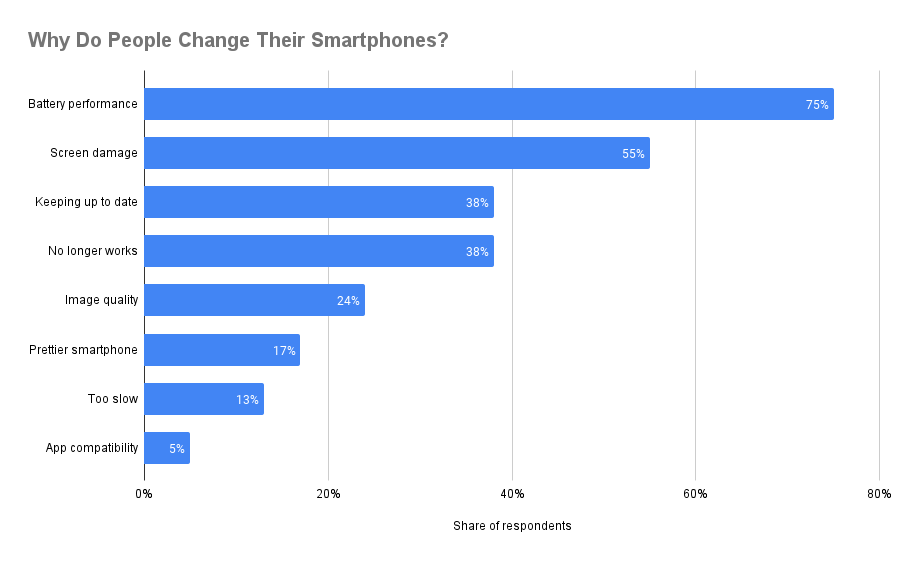
| Why Do People Change Their Smartphones? | |
|---|---|
| Share of respondents | |
| Battery performance | 75% |
| Screen damage | 55% |
| Keeping up to date | 38% |
| No longer works | 38% |
| Image quality | 24% |
| Prettier smartphone | 17% |
| Too slow | 13% |
| App compatibility | 5% |
- Perhaps the most obvious reason for people upgrading their phone is down to battery performance. Between 2-3 years is when a smartphone battery will start to become problematic 13. 75.0% of people say this is why they upgrade their smartphone.
- Screen damage is the second most popular reason for people upgrading their smartphone. 55.0% of people cite this as why they switch their phone to a newer model.
- The least popular reason people upgrade is down to app compatibility, with only 5.0% of people saying this why.
Smartphone Upgrade Frequency by Age
People of different ages keep their smartphones for different periods of time before they upgrade.
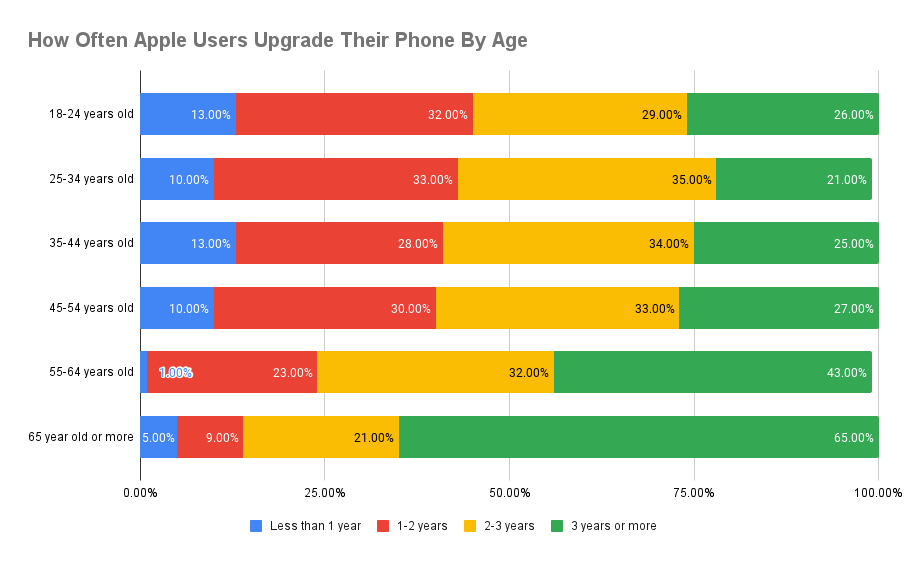
| How Often Apple Users Upgrade Their Phone By Age | ||||
|---|---|---|---|---|
| Less than 1 year | 1-2 years | 2-3 years | 3 years or more | |
| 18-24 years old | 13.00% | 32.00% | 29.00% | 26.00% |
| 25-34 years old | 10.00% | 33.00% | 35.00% | 21.00% |
| 35-44 years old | 13.00% | 28.00% | 34.00% | 25.00% |
| 45-54 years old | 10.00% | 30.00% | 33.00% | 27.00% |
| 55-64 years old | 1.00% | 23.00% | 32.00% | 43.00% |
| 65 year old or more | 5.00% | 9.00% | 21.00% | 65.00% |
- The graph above shows the upgrade habits of different age groups. It illustrates the percentage of people who upgrade during a certain time period in a phone’s life cycle.
- The majority (32.0%) of 18-24-year-olds upgrade their smartphone after one to two years. 13.0% of them upgrade in less than a year, 29.0% keep hold for between two and three years. 26.0% of this age group keeps their phone for over three years.
- Most (35.0%) 25-34-year-olds keep their handset for between two and three years. 33.0% of them for one to two years. 21.0% of them upgrade after three years, and 10.0% upgrade before one year is even up.
- In the 35-44 age group, 13.0% don’t make it to a year before upgrading. 28.0% hold out for one to two years. 34.0% hit the average two to three years. 25.0% last over three years before getting a new handset.
- Of those aged 45-54, 10.0% upgrade within 12 months, 30.0% one-to-two years, 33.0% between two to three years, and 27.0% go past the three-year mark.
- In the 55-64 age bracket, only 1.0% upgrades before 12 months are up, 23.0% in one to two years, 32.0% in two to three years, and 43.0% go over three years with the same phone before upgrading.
- Over 65s keep their phone mainly over three years (65.0%). 21.0% last two to three years, 9.0% upgrade between one and two years, and 5.0% only keep their phone a maximum of twelve months.
Smartphone Upgrade Frequency by Device (iPhone vs. Android)
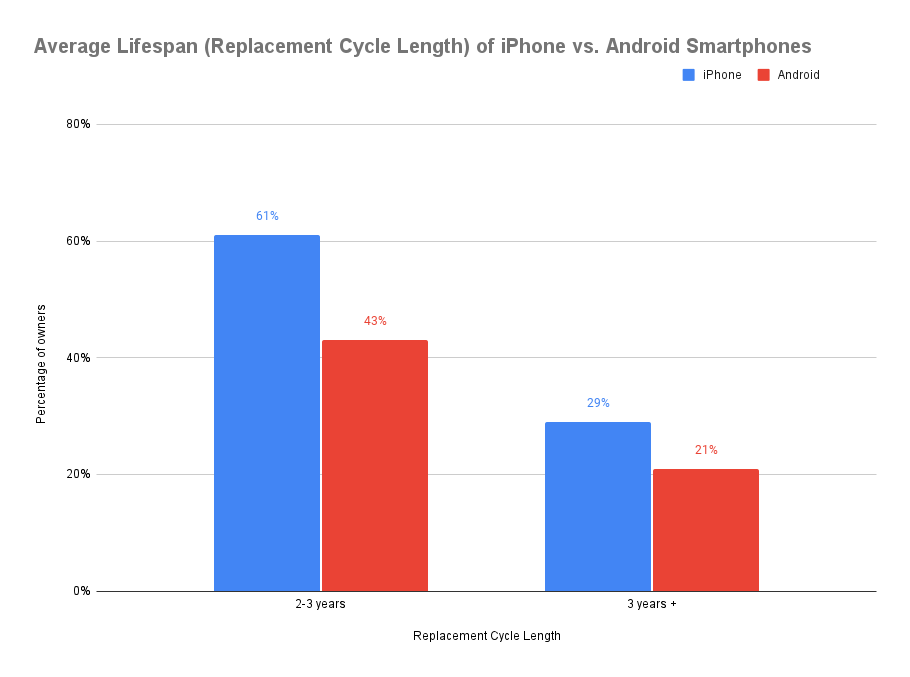
| Average Lifespan (Replacement Cycle Length) of iPhone vs. Android Smartphones | ||
|---|---|---|
| iPhone | Android | |
| 2-3 years | 61% | 43% |
| 3 years + | 29% | 21% |
- As the above data illustrates, Apple iPhone owners keep their smartphone for longer than Android owners.
- 61.0% of Apple owners keep their phone for between two to three years, compared to 43.0% of Android owners.
- 29.0% of iPhone owners make it over three years with their handset. Only 21.0% of people with Android owners manage this.
What Happens to an Existing Device When a User Upgrades?
People have different habits when it comes to disposing of their old smartphone post-upgrade, according to SellCell’s 2022 Earth Day survey.
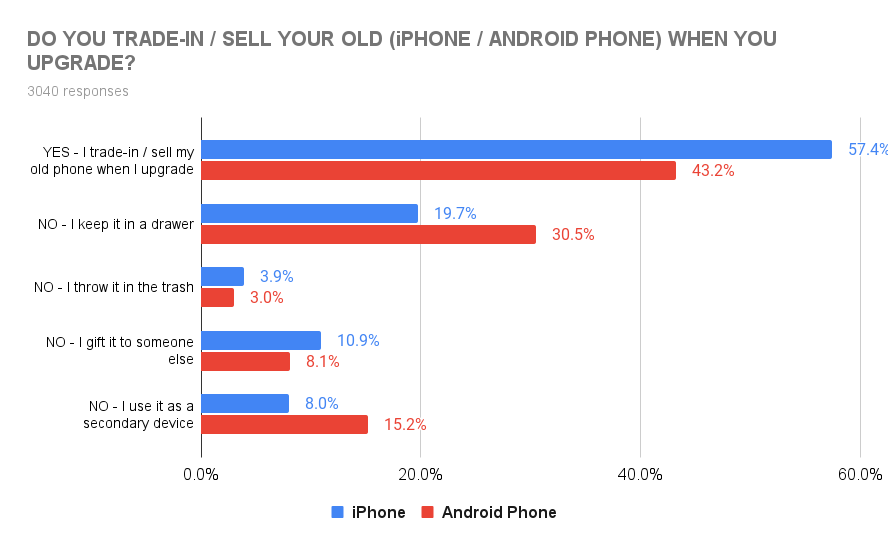
| Do you trade-in / sell your old (iPhone / Android Phone) when you upgrade? | ||
|---|---|---|
| iPhone | Android | |
| YES – I trade-in / sell my old phone when I upgrade | 57.4% | 43.2% |
| NO – I keep it in a drawer | 19.7% | 30.5% |
| NO – I throw it in the trash | 3.9% | 3.0% |
| NO – I gift it to someone else | 10.9% | 8.1% |
| NO – I use it as a secondary device | 8.0% | 15.2% |
- 57.4% of iPhone owners trade-in or sell their handset on upgrade, vs. 43.2% of Android owners.
- 19.7% of iPhone users will put the old phone in a draw, while a concerning 30.5% of Android owners leave their phone languishing in this way.
- 3.9% (iPhone) v.s 3.0% (Android) will throw it in the trash. This can cause environmental damage, and is the worst thing you can do with an old smartphone.
- Some people gift their phone to another person. 10.9% of Apple owners do this, with 8.1% of Android owners following suit.
- 8.0% of iPhone users will make the old phone a secondary device, keeping it. 15.2% of Android owners practice this.
Are We Holding Onto Our Smartphones for Longer? Perhaps Not…
As the data in this research shows, on a global level, we are keeping our smartphones for a longer period. However, research suggests that economic recovery (whenever that happens) and the rollout of 5G will shorten the lifespan of some phones slightly 16.
Either way, when we upgrade our smartphone, we should do so responsibly. This means that we should dispose of our old smartphone in a conscientious manner (i.e. not throwing it in the trash). Trading your smartphone in with a brand like SellCell—via one of its 40 plus trusted buyback vendors—means you can dispose of your smartphone responsibly and make some cash, too. This is by far the best way to dispose of an old handset when a person upgrades their phone.
